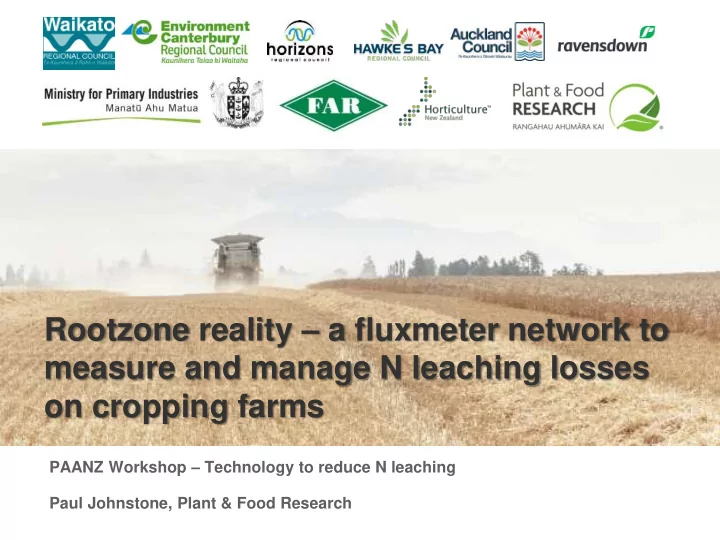

The New Zealand Institute for Plant & Food Research Limited Rootzone reality – a fluxmeter network to measure and manage N leaching losses on cropping farms PAANZ Workshop – Technology to reduce N leaching Paul Johnstone, Plant & Food Research
A rapidly changing farming landscape » Goal of farmers hasn’t changed – Farming for profit while minimising losses » Period of regulatory change – intent vs demonstrate » Rise of tools for predicting whole farm outcomes and setting associated policies » Model vs measure » Recognition that farming systems are complex! The New Zealand Institute for Plant & Food Research Limited
Plugging a gap – ‘ Rootzone reality’ » Provide growers and regional authorities with robust measurements of N and P leaching losses from cropping farms across sites and seasons under GMP’s » Why? » Need more measured data for discussion » Need an idea about whether GMP’s have the desired impact » Need to do it together to inform models and policy Overview: » Summary of network and sites » Year 1 findings » The role for precision technologies? The New Zealand Institute for Plant & Food Research Limited
Measuring losses - tension fluxmeters 200 mm » Why use tension fluxmeters? » Permanent and non-intrusive 150 mm » Capture complete drainage events 50 mm » Cost-effective approach » What is a tension fluxmeter? 1000 mm » PVC pipe that intercepts drainage (stores ~14 L) » Silica sand and DE reduce sediment transfer » Passive wick » Drainage pumped to surface through plastic tubes 150 mm The New Zealand Institute for Plant & Food Research Limited
Context - installing and testing fluxmeters » Installation process » Representative areas of fields, not extremes » Hole augured, unit lowered, soil carefully repacked » Top of fluxmeter is at a depth of 1.0 m » Testing performance » Disturbed soil needs to settle » Soil water balances to look at inputs (irrigation + rainfall) and outputs (drainage) The New Zealand Institute for Plant & Food Research Limited
The fluxmeter network » Network design » Four monitor regions » Three sites per region » 12 fluxmeters per site (144 units) » Sites » Commercial fields » Range of soils, climates and management practices » Avoided high water tables, artificial drainage and stones The New Zealand Institute for Plant & Food Research Limited
Key measurements Soil fertility (N, P, C…) Crop biomass (DM, N uptake, export) Drainage (volume, NO 3 , NH 4 , DRP, Total P) The New Zealand Institute for Plant & Food Research Limited
Drivers of nutrient losses – loading and drainage Low drainage High drainage Low soil fertility Low loss Low loss High soil fertility High risk High loss Implication: manage soil fertility and drainage The New Zealand Institute for Plant & Food Research Limited
Measured loading – soil nitrogen 400 (kg/ha, to 1 m depth) N available today… 300 Mineral N High 200 Moderate 100 Low 0 1 2 3 4 5 6 7 8 9 10 11 12 400 (kg/ha, to 1 m depth) N available soon… 300 High AMN 200 Moderate 100 Low 0 1 2 3 4 5 6 7 8 9 10 11 12 Hawke’s Bay Waikato/Auckland Canterbury Manawatu The New Zealand Institute for Plant & Food Research Limited
Measured loading – soil phosphorus 250 (mg/kg, to 0.2 m depth) 200 Above Olsen P 150 optimum 100 50 Optimum 0 1 2 3 4 5 6 7 8 9 10 11 12 Hawke’s Bay Canterbury Manawatu Waikato/Auckland The New Zealand Institute for Plant & Food Research Limited
Measured drainage Monitoring period (months) 13 12 12 11 12 5 13 12 13 5 7 6 13 12 12 11 12 5 13 12 13 5 7 6 3000 0 NR 2500 250 Rainfall and irrigation (mm) Drainage Rainfall Irrigation Drainage (mm) 2000 500 Long term average rainfall NR No result 1500 750 1000 1000 500 1250 0 1500 1 2 3 4 5 6 7 8 9 10 11 12 Hawke’s Bay Waikato/Auckland Canterbury Manawatu The New Zealand Institute for Plant & Food Research Limited
Measured nitrogen losses Cumulative mineral N losses (kg/ha) What represents an acceptable economic loss? What represents an acceptable environmental loss? Hawke’s Bay Canterbury Manawatu Waikato/Auckland The New Zealand Institute for Plant & Food Research Limited
Measured phosphorus losses Cumulative Total P losses (kg/ha) Not an economic driver What represents an acceptable environmental loss? Hawke’s Bay Canterbury Manawatu Waikato/Auckland The New Zealand Institute for Plant & Food Research Limited
Overall synthesis from network to date » Key stats since installation and October » Captured drainage ranged from 0.3 to 611 mm » N losses ranged from 0.2 to 226 kg N/ha » P losses ranged from 0.01 to 0.56 kg P/ha » Winter and spring losses dominate » Rainfall is a key driver; reduce loading? » Irrigation not resulting in significant drainage during summer » High soil N and P levels = high risk » Value of data increases with long- term trends… The New Zealand Institute for Plant & Food Research Limited
Implications for precision technologies? » Tight management of water and nutrients is important to limit losses » GMP’s are working » Precision technologies can also help » Likely to require different solutions » mapping, sensing, VRI, VRN… » How to decide what to use and when? The New Zealand Institute for Plant & Food Research Limited
Acknowledgements Grower collaborators Project managers: Diana Mathers (FAR) and Angela Halliday (Horticulture NZ) PFR team: Matt Norris, Shane Maley, Mike George, Gina Clemens, Steve Thomas, Steve Green, Carlo van den Dijssel, Paulo Zuccarini, Nathan Arnold, Adrian Hunt, Christina Finlayson, Glen Clark and Peter Wright. The New Zealand Institute for Plant & Food Research Limited
The New Zealand Institute for Plant & Food Research Limited Paul.Johnstone@plantandfood.co.nz
Recommend
More recommend